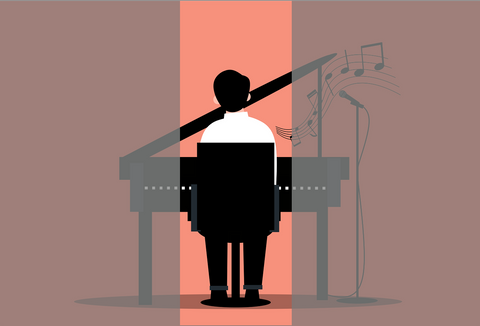How come an MP3 sounds more "choppy" or has less "depth" and audio range than a CD?
There are a lot of reasons audio can sound bad, including the physical speakers you're using to listen to it. But by far and away bitrate is, in 2024, the most common cause of unsatisfactory audio.
Learn how we became desensitised to good audio range and volume balancing via digital normalisation and low-bitrate en-masse streaming from Spotify, and most importantly reclaim your right to high fidelity music!
Context - Sound and Transmission
All audio is grounded in waves. Whether it's a live performance or a streamed podcast can be defined as a wave, or data derived from a wave.
These waves can be defined by how fast they move, how far the move, and how long they move for. These metrics are what you'll see described as Frequency, Amplitude and Propagation.

Now, if you wanted to recreate this wave, you'd need that data. To accurately copy a piece of music you'd need to know the frequency and amplitudes of all those waves in as much detail as possible, and then play them through a speaker which can vibrate in a manner which recreates those waves perfectly.
To put it simply: For a transmission of music to sound like the real thing, the recording needs to hold a lot of data about the original sound wave.
What is Audio Bitrate?
Bitrate in audio terminology refers to the amount of data processed in a set amount of time. A "bit" is a measurement of data and "rate" is the speed and frequency with which something happens, so "Bitrate" means the rate of data!
As we just identified, a recording or stream of audio needs to accurately recreate the data from a sound wave, but we don't simply chuck the wave itself into a pipe and it comes out the other end when we're listening to Spotify, do we?
Therefore, we need to store than data somehow else. In the case of Spotify and streamed music, the audio data is digitised into files such as MP3.
More on MP3 later, for now the important thing is that the way we store and transmit this data isn't the same as the way the sound was originally made. This means that all sound wave data has to have been interpreted, encoded, changed to some degree to actually allow us to store and transmit it.
All this boils down to bitrate: the amount of data per second we transmit. If an audio file contains a high bitrate, more data is transferred per second. If an audio file has a low bitrate, less data can be sent per second. For this reason, bitrate is measured in Kbps (Kilobits per second).
How does bitrate affect audio quality?
Imagine asking a pianist to compose with half a piano. You might get a great few pieces of music, but the highs won't get as high, the lows wont get as low, and eventually all music will start to sound the same because of the restriction of only using half the piano.

Bitrate works similarly. Each key on the piano is like a piece of data, and by lowering the bitrate we limit the potential for range, depth and quality just like the pianist.
This can lead to lack of volume dynamics, EQ settings making far less difference to audio, and even entirely missed instruments. I listened to the CD of one of my favourites from Spotify the other day and didn't even realise there was a bassline in the intro until I heard the CD.
How Did Low Bitrate Audio Become So Common?
The bitrate debate used to be much more linear, as audio was originally very crudely (but accurately) recreated as "Raw" files. Things like a CD reflect this with their very high bitrate of 1411 Kbps.
As time went on, digital files were compressed more and more, with some digital formats containing higher-bitrate audio (FLAC, WMA) and some containing low-bitrate audio (MP3) as low as 320 or even 126 Kbps!
With less and less data to work with per second, audio became less dynamic, with volume changes and layers all becoming more binary. Most songs in these formats have "loud" and "quiet" sections with little room to create a truly deep and dynamic audio experience.
This was mainly done to support faster sharing of files using the internet:
Why Spotify Uses MP3 Bitrates
As mentioned, these compressed formats are most common for audio streaming as the audio file has to be small enough to reliably send over broadband and Wi-Fi. There would be no reason streaming a 1411 Kbps audio stream if your broadband and servers can only process a thousand of those at a time.
Consider that Spotify streams to millions of users, and the compression becomes more important to them, as a business, than the audio quality is. In the same bandwidth as streaming one CD-quality file at 1411 Kbps they can stream over 4 times as many MP3-quality files.
From a server and business standpoint, producing that audio en-masse is more important than producing it at high fidelity.
From a customer standpoint, if their internet speeds were poor and they tried to stream 1411 Kbps audio they may have buffering, skips and pauses. Ultimately, a more stable but lower fidelity option is more appealing to a modern audience.
How To Listen to High Bitrate Digital Audio in 2024
When it comes to curbing the trend and accessing the lofty 1411 Kbps audio of CD's, your options are twofold:
1. Use a CD. Home and portable CD players are still very much in demand for their superior quality, and besides owning the physical media is the best way to avoid missing out on content.
2. Stick to FLAC or WMA files. Not all digital files are compressed, some focus more on the accurate digital recreation of audio. If you use FLAC or WMA files (with audio that actually has data in that range) you'll be able to enjoy higher-quality audio without needing a CD player.
Whether you change your listening habits or not, I'll always take an opportunity to highlight the rise of music streaming, TV streaming and always-online entertainment is not the be-all and end-all. There's a world of devices out there to allow you to truly own your media, experience it in the best way possible, and free yourself from reliance on the internet.

Leave a comment